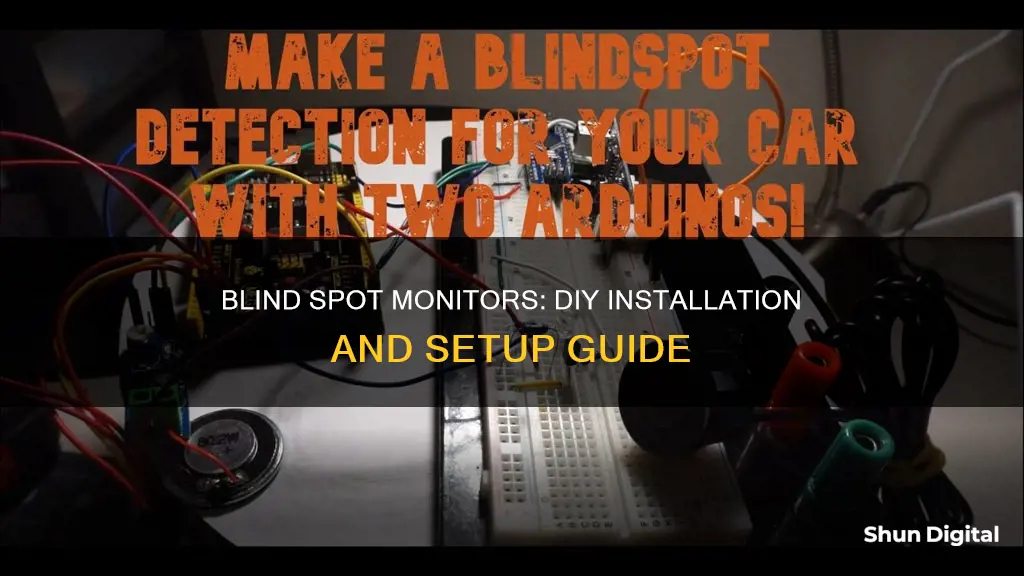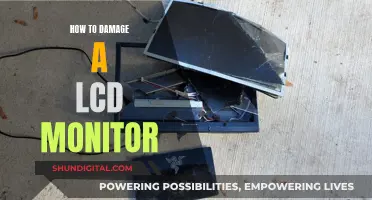
Blind-spot monitoring (BSM) is a safety feature that helps prevent accidents by alerting drivers to vehicles in their blind spots. While BSM was initially only available in high-end luxury cars, it has since become more common in newer cars of all types, and it can also be added to older vehicles as an aftermarket product. Aftermarket blind spot monitoring systems vary in price, with the most affordable systems costing $250 or less, mid-range systems costing between $250 and $500, and high-end systems costing $500 or more. These systems can be installed by professionals or, in some cases, by the vehicle owner.
What You'll Learn

Sensor-based systems
Ultrasonic sensors are not the only type of sensor used in BSM systems. Radar and sonar sensors are also used to detect vehicles in blind spots. Radar sensors, in particular, are used in some of the more advanced systems, which project a beam that bounces back when reflecting off the surface of another vehicle. When the beam returns to the system, the driver receives an alert.
- Mount the sensors on the rear of your car, near the corners of your bumper, and out of the way of any exhaust pipes or other obstacles.
- Route the wires from the sensors to the inside of your car. You may need to drill a small hole in the firewall to do this.
- Install the control unit, typically under the dashboard.
- Install the LED lights or other warning indicators, typically on the inside of the side mirrors.
- Connect the wires from the sensors and the control unit to the power supply in your car.
Setting Up Dual Monitors: A Step-by-Step Guide
You may want to see also

Camera-based systems
Camera-based blind spot monitoring systems are an effective way to increase safety and driver confidence by providing a clear view of vehicles, cyclists, and pedestrians in a driver's blind spot. These systems are particularly useful for changing lanes or manoeuvring in tight spaces, such as parking lots, and can provide early warnings to prevent accidents.
When choosing a camera-based system, it is important to consider your budget and DIY skills. These systems can cost upwards of $300 and may require professional installation, depending on your comfort level with working on your vehicle. Additionally, some vehicles have pre-wiring for blind spot monitoring, which can make installation easier.
To install a camera-based blind spot monitoring system, you will need to carefully follow the instructions provided with the system and purchase additional tools, such as a drill and wire cutter. The process typically involves mounting the camera(s) on the side of the vehicle, routing wires to the inside of the car, and installing the control unit and warning indicators.
It is worth noting that camera-based systems may be more challenging to install than sensor-based systems, which are generally less expensive and easier to set up. However, camera-based systems offer a clearer view of the blind spot and can provide a valuable layer of protection while driving.
Understanding IPS LCD Monitors: How Do They Work?
You may want to see also

OEM blind spot monitoring upgrades
Upgrading your car to include an Original Equipment Manufacturer (OEM) blind spot monitoring (BSM) system can significantly improve safety and driver confidence. BSM systems use radar, cameras, or sensors to detect vehicles in your blind spots and alert you with a visual or audible warning.
There are a variety of OEM blind spot monitoring systems available for different makes and models of cars. For example, Jeep offers OEM BSM as a factory option for the 2018-2024 Wrangler and the 2020-2024 Gladiator. Ram Truck also offers OEM BSM for the 2019-2024 1500 and the 2019-2022 2500-3500 models.
If your car didn't come with OEM BSM, you can often add it as a retrofit option. For example, Honda Insight owners have discussed the possibility of retrofitting the 2021 Insight EX and Touring trim BSM system to their 2019/2020 models. However, programming issues and connectivity concerns have been raised as potential obstacles.
When considering an OEM BSM upgrade, it's important to choose a system that is compatible with your vehicle and decide on the type of alerts you prefer, such as visual or audible alerts. While BSM systems can be installed by professionals, they can also be a do-it-yourself project for those with the necessary skills and tools.
Monitor Malfunction: Signs Your Screen is Failing
You may want to see also

Aftermarket blind spot monitoring systems
There are two main types of aftermarket blind spot monitoring systems: sensor-based and camera-based. Sensor-based systems use ultrasonic sensors mounted on the rear of the car to detect objects in your blind spots. When something enters your blind spot, the system will typically alert you with an LED light in your side mirror or a beeping sound from inside the car. Camera-based systems, on the other hand, use a small camera mounted on the side of the car to provide a feed of your blind spots, which is displayed on your dashboard or rearview mirror.
When choosing an aftermarket blind spot monitoring system, consider your budget, DIY skills, and your car's features. Sensor-based systems are generally more affordable, easier to install, and can be purchased for as little as $50 to $100. Camera-based systems, on the other hand, can cost upwards of $300 and may require professional installation due to their complexity. However, they can provide a clearer view of your blind spots.
If you decide to install a sensor-based system yourself, here are the general steps you can follow:
- Mount the sensors on the rear corners of your bumper, ensuring they are clear of any exhaust pipes or other obstacles.
- Route the wires from the sensors to the inside of your car. You may need to drill a small hole in the firewall.
- Install the control unit under the dashboard.
- Install the LED lights or other warning indicators, typically on the inside of your side mirrors.
- Connect the wires from the sensors and the control unit to the power supply.
It's important to carefully read the instructions that come with your chosen system and purchase any additional tools you may need, such as a drill and wire cutter.
Some popular aftermarket blind spot monitoring systems include the Rexing M2 Smart Mirror Dash Cam with BSD ADAS, Crimestopper SafetyPlus Universal Front and Rear Blind Spot Detection System, and the Pyle Ultrasonic Blind Spot Detection System.
Setting Up Your ASUS Portable Monitor: A Step-by-Step Guide
You may want to see also

Benefits of blind-spot monitoring
Blind-spot monitoring is a safety feature that has become increasingly common in newer cars. It can help to prevent lane-change accidents by alerting drivers to vehicles in their blind spots.
Reduced Lane Change Collisions
This is the most significant advantage of blind-spot monitoring. Blind spots are particularly dangerous during lane changes, as a vehicle might be lurking right where you can't see it. Blind-spot monitoring acts as an early warning system, detecting vehicles in your blind spots and alerting you with a visual or audible signal. This allows you to make informed decisions about changing lanes and helps you avoid potential collisions. Studies suggest that blind-spot monitoring can reduce lane-change crashes by up to 14%.
Enhanced Driver Confidence
Knowing that you have a system actively monitoring your blind spots can significantly boost your confidence behind the wheel. This is especially valuable for new drivers or those who regularly navigate heavy traffic conditions. The peace of mind that blind-spot monitoring offers allows drivers to focus more on the overall driving experience rather than constantly worrying about what's out of sight.
Improved All-Around Awareness
While mirrors are crucial, they have limitations. Blind-spot monitoring complements your visual checks by providing a wider range of awareness. This is especially helpful on multi-lane highways or when maneuvering in tight spaces like parking lots. Blind-spot monitoring can detect vehicles approaching from behind or alongside you, even motorcycles that might be harder to spot in mirrors.
Increased Safety for Vulnerable Road Users
Blind spots can pose a particular threat to vulnerable road users like cyclists and pedestrians. Blind-spot monitoring can help detect these smaller objects, prompting drivers to exercise extra caution when turning or changing lanes, thus contributing to a safer environment for everyone on the road.
Potential Insurance Discounts
Some insurance companies may offer discounts to drivers whose cars are equipped with blind-spot monitoring. This is because blind-spot monitoring can demonstrably reduce the likelihood of accidents, leading to lower insurance costs for drivers and companies alike.
In conclusion, blind-spot monitoring is a valuable safety feature that can significantly enhance your driving experience. While not a substitute for safe driving practices like proper mirror checks and shoulder checks, it adds another layer of protection, making it a worthwhile investment for any car.
Locating Your HP Monitor: Finding the Model Number
You may want to see also
Frequently asked questions
A blind spot monitor is a safety feature that helps prevent lane-change accidents by alerting drivers to vehicles in their blind spots.
A blind spot monitor uses sensors or cameras to detect vehicles in a driver's blind spots. When a vehicle is detected, the system alerts the driver with a visual or audible warning.
Blind spot monitors can help prevent accidents, increase driving awareness, and boost driver confidence. They can also complement a driver's visual checks by providing a wider range of awareness, which is especially useful on multi-lane highways or when maneuvering in tight spaces.
The cost of a blind spot monitor can vary depending on the type and sophistication of the system. Basic sensor-based systems typically cost between $50 and $100, while more advanced camera-based systems can cost upwards of $300. The installation cost for an aftermarket blind spot monitor is typically at least $200.







